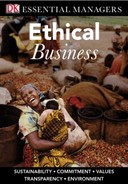Dealing with Dishonesty
Lying and dishonesty in all forms—be it giving false information in company financial records, dishonest behavior or theft by employees, or false or misleading marketing and advertising—can be extremely damaging to an organization. Even if the organization is not prosecuted for its actions, its reputation can be destroyed if it is found to be participating in dishonest practices.
Being alert to fraud
It has been suggested that in times of economic downturns fraudulent behavior increases. Even in the good times, however, it is important for every manager to understand what constitutes fraudulent and dishonest behavior, how they can protect themselves from being a victim of it, and how they can avoid participation in any activities that could be considered fraudulent or lead to fraud[].
Fraud—any untrue statement or form of communication that deceives, manipulates, or conceals facts to create a false impression that can damage others.Understanding financial fraud
Fraud in accounting and finance can destroy an organization. It typically involves providing incorrect information in financial reports that contain the key data about a company’s financial health—data on which investors and others base their decisions. Providing inaccurate information in financial reports can lead to lawsuits and criminal charges, even if the errors were not intentional. Accounting fraud has frequently been a headline news topic in the 21st century, and as a result many countries have passed legislation to clamp down on the practice. However, there are a number of basic strategies you can use to minimize the risk of your organization participating in financial fraud:
Elect directors with financial experience in proportion to the size of the company.
Clamp down on minor dishonesty to create a culture in which fraud is not tolerated.
Avoid pressures that are likely to encourage fraud, such as unreasonably high sales targets.
Implement an antifraud policy that sets out standards of behavior, and encourage employees to self-regulate under that policy.
Provide training for all employees, so that everyone within your organization is clear about what could lead to fraud.
Conduct regular internal audits.
Detecting employee fraud
Every manager must be vigilant for dishonest and fraudulent behavior among employees. This can include stealing money or products, taking office supplies, expense account manipulation, and claiming overtime when they haven’t worked extra hours.
Theft by employees is an extremely serious issue, costing businesses billions each year, and in the worst cases, even causing bankruptcy. Studies have shown that 79 percent of people steal or are tempted to steal from their employers. Stolen items may range from something as small as paper clips to something as serious as computer software. Sometimes, employees steal copyrighted materials and pass them off as their own.
Employees of all levels are tempted to commit theft; although upper-level managers are not as likely to steal, they have access to more valuable items, and so could potentially cause significantly more damage to the organization. Rarely is theft committed by employees as a result of material need. More often, workplace items are stolen in an attempt to get a thrill or because of greed.
Minimize the risk of theft
Do background checks on new employees for problems in previous jobs.
Monitor expense accounts and resources that could be taken.
Encourage employees to report workplace theft they witness.
Consider surveillance cameras for serious problems.
TIP
Always check the accuracy and source of documents, and report any suspicions of improper behavior to a senior member of staff.
